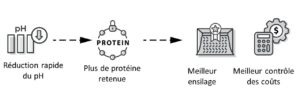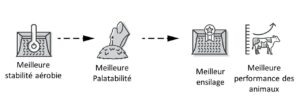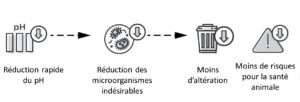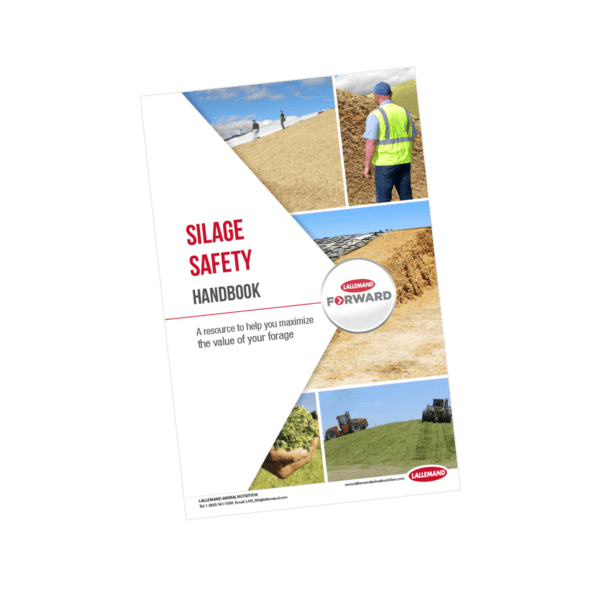Le processus de fermentation de l’ensilage est une bataille entre les « bons » et les « mauvais » micro-organismes. On compte parmi les « bons » micro-organismes les bactéries lactiques, qui permettent d’ensiler la culture. Les « mauvais » micro-organismes qui altèrent les récoltes incluent les clostridia, les entérobactéries, les bacilles, les levures et les moisissures. Tous nuisent à la qualité de l’ensilage.
Les additifs d’ensilage contiennent des bactéries vivantes et sont parfois combinés à des enzymes. Les bactéries sont appliquées pour inoculer du fourrage fraîchement récolté avec de « bons » micro-organismes. Lorsqu’elles sont présentes, les enzymes améliorent la digestibilité des fibres et augmentent la teneur en sucres solubles pour les « bonnes » bactéries.
Les inoculants servent principalement :
- À stimuler ou à assurer une fermentation rapide et efficace
- À inhiber la détérioration aérobie
Avantages des conservateurs d’ensilage
L’intégration d’un conservateur peut favoriser les volets suivants :
- Optimisation de la valeur des aliments pour animaux. Grâce à l’application d’additifs, le fourrage atteint rapidement le niveau de pH auquel sont inhibées les bactéries qui dégradent les protéines. Il en résulte une meilleure rétention des protéines dans l’ensilage d’herbe.

- Optimisation de la consommation. Les additifs limitent la production d’éléments indésirables, comme les amines biogènes.

- Amélioration de la sécurité. Les listeria et les spores butyriques sont sensibles à un faible pH. Grâce à une acidification rapide, ces micro-organismes ont moins de chances de se développer.

- Diminution des pertes. Les additifs à base de bactéries lactiques réduisent les pertes de matière sèche en accélérant l’acidification. D’autres additifs possèdent des propriétés anti-fongicides, qui réduisent les pertes causées par les levures et les moisissures, ainsi que l’échauffement du front d’attaque de l’ensilage après ouverture.

Moteurs de la fermentation
Les conservateurs bactériens pour fourrage contiennent généralement des bactéries lactiques efficaces (homofermentaires) tels que lactobacillus plantarum, pediococcus acidilactici ou pediococcus pentosaceus. Ces bactéries lactiques accélèrent la chute du pH et diminuent la production d’acides acétique et butyrique.
Inhibition de la détérioration
Les conservateurs conçus pour inhiber la détérioration contiennent souvent des bactéries lactiques spécifiques – par exemple des bactéries hétérofermentaires telles que lactobacillus buchneri – ou des bactéries productrices d’acide propionique. Ces additifs doivent être utilisés sur des fourrages plus sujets à la détérioration aérobie, comme l’herbe (>30 % de MS), le maïs, les ensilages de céréales, le maïs grain humide, les ensilage de céréales et les fourrages en balles.
Souches de bactéries
Toutes les bactéries ne sont pas identiques, même si elles portent le même nom. Chaque entreprise dispose de souches uniques, testées et développées dans des conditions rigoureuses. L’efficacité des souches bactériennes doit être prouvée avant qu’on ne les applique sur le fourrage. Recherchez les numéros d’identification des souches et assurez-vous qu’ils correspondent à ceux des essais.
Autres aides à la fermentation
Un conservateur d’ensilage bactérien est une sorte d’aide de fermentation, ou de stimulant de fermentation. En général, il donne un résultat plus prévisible que d’autres auxiliaires de fermentation, comme:
- Les sucres : L’ajout de sucres, comme la mélasse, peut améliorer la fermentation de certains fourrages. Cependant l’application de mélasse peut aggraver les pertes d’effluents. De plus, le taux d’application élevé et la viscosité rendent l’application plus difficile que celle d’autres additifs.
- Les sous-produits : La pulpe d’agrumes ou d’ananas peut être utilisée comme aide à la fermentation. Toutefois, ces produits ne sont disponibles que de façon saisonnière et pour un nombre limité de producteurs.
Découvrez comment sélectionner le meilleur conservateur pour votre exploitation



